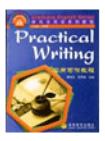研究生英语系列教程·实用写作教程
出版时间:1999-10 出版社:蓝色畅想 作者:秦寿生,杨同福 主编,李小红 等编 页数:215
Tag标签:无
前言
在“科教兴国”的基本方针指引下,我国的研究生教育有了蓬勃的发展。随着各层次、各类型研究生教学的开展,英语教学也面临着越来越高的要求。《研究生英语系列教程》就是为了适应这一新的形势而编写的系统教材。 《研究生英语系列教程》是以教育部(原国家教委)颁布的《非英语专业研究生英语教学大纲》为依据,根据我国研究生教学的实际情况和国家对21世纪高级技术与管理人才的要求进行编写的。考虑到目前我国研究生层次多,其入学英语水平参差不齐,需要以不同水平为起点,因此本系列教程的编写原则是既从当前研究生的实际水平出发,也力求满足新世纪对高层次人才的期望既重视培养学生扎实的语言技能,更注重提高其全面的应用能力;既注意语言教育,更重视素质教育。
内容概要
本书是教育部“高等教育面向21世纪教学内容和课程体系改革计划”的研究成果,是面向21世纪课程教材和教育“九五”规划教材。本书是《研究生英语系列教程》基础阶段的重要组成部分,通过大量范例和练习,旨在培养研究生较好较快地掌握各种写作技能,提高书面交际的能力。 本书可作为高等学校非英语专业硕士生、研究生课程班及MBA班学生使用的教材,还可供相应水平的读者使用。
书籍目录
Unit One Basic Skills in Writing Paragraphs 1. 1 Introduction to Paragraphs 1.1.1 Paragraph 1.1.2 Essay 1.2 Organization of a Paragraph 1.2.1 A Narrowed-down Topic 1.2.2 A Reasonable Sequence 1.3 Qualities of a Good Paragraph 1.3.1 Unity 1.3.2 Coherence 1.3.3 Continuity 1.3.3.1 Specific Devices AidingTransitions 1.3.3.2 Useful Transitional Words 1.3.4 CompletenessUnit Two Basic Skills in Writing Essays 2. 1 Introduction to the Essay 2.1.1 Beginning an Essay. Creating an Opening Paragraph 2.1.2 Ending an Essay: Creating a Concluding Paragraph 2.1.3 Developing the Body Paragraphs 2.1.4 UsingTransitions 2.2 Basic Skills in EssayWriting 2.2.1 Essay Development by Chronological Order 2.2.2 Essay Development by Space 2.2.3 Essay Development by Cause and Effect 2.2.4 Essay Development by Comparison and Contrast 2.2.5 Essay Development by Examples 2.2.6 Essay Devatopment by Classification 2.2.7 Essay Development by DefinitionUnit Three Writing for Practical Communication 3.1 Letter Writing 3.1.1 The Layout of a Letter 3.1.2 Social Correspondence 3.1.2.1 Personal Letters and Notes 3.1.2.2 Invitation Letters and Cards 3.1.2.3 Thank-you letters 3.1.3 Business Letters 3.1.3.1 Letters of Application and Resume 3.1.3.2 Letters of Recommendation 3.2 Ordinary Official Documents 3.2.1 Contracts 3.2.2 Agreements 3.2.2.1 Parts of an Agreement 3.2.2.2 The Language 3.2.2.3 MEMOs (Memorandums) 3.3 Advertisements, Notices, Posters and Announcements 3.3.1 Commercial Advertisements 3.3.1.1 Planned Objective of an Advertisement 3.3.1.2 The Layout of an Advertisement 3.3.1.3 Suggestions on Copy Writing 3.3.2 Notices 3.3.3 Posters 3.3.4 AnnouncementsUnit Four Summary WritingUnit Five Technical WritingGlossaryAcknowledgements
章节摘录
Types of Fishermen Some people would classify fishermen according to where they fish——either in fresh or salt water,or in streams.Iakes,bays,or oceans.Otherswould group fishermen by what they use to attract the fish-natural bait orartificial lures.Still others would make the division according to tackle-fly casters.revolvin~~~~reels,or bait casting reels.You could also categorize fishermen asthose who do it forfood,those who do it for sport,and those who do it forfun.Now these systems of classification have some merit.but I believe they allfail to focus on the main objective of fishing.which is to catch fish.In twenty-five years of serious fishing.I have observed that most fisherrTlen use a varietyoftackle。switch from bait to lUreS and back again.and fish wherever they can my mind the factor that really distinguishes them is whether or not theycatch fish.Using this criterion.1 would divide fisherTnen into three categories:those who catch fish regularly;those who don’t catch fish and don’t knowwhy;and those who dont catch fish and dont care why.
编辑推荐
《实用写作教程》可作为高等学校非英语专业硕士生、研究生课程班及MBA班学生使用的教材,还可供相应水平的读者使用。
图书封面
图书标签Tags
无
评论、评分、阅读与下载
用户评论 (总计32条)
- 写作老师要求的教材,研究生教材
- 快递还行,从北京发的货,两天左右就到了。书的话,我们的教材,还行。
- 为准备GRE的AW 部分issue而买的书。很实用。很推荐。
- 老师要求买的,很好,特别是书信格式的方法写得很清晰
- 书本不错 全新,物流也不错,很快就到了。服务很好很到位,支持
- 发货很快,书质量也很好,正版的。
- 很好的 一本书 ~
- 感觉还是不错的,可以看看的
- 方便学习才买的 希望会有帮助
- 教给怎么写论文的!
- 不错 质量是正版的
- 因为是考研的书,所以买来看看。确实不错,讲essay ,letter 等等的,都附有例子的。
- 不错 速度黑快
- 快递速度很快,很满意。是正版书
- 印刷不错,上课要用的
- 好书,重点突出,有质量有内函。
- 还不错,发货速度蛮快的。
- 适合研究生的写作教材
- 可以看一下,还好,研究生课程用书
- 学校阅读课要求的教材,因为是学校老师编的所以比较贴合我们的上课要求。
对写作有一定的帮助。 - 对英语论文写作很有用~
- 写作课外教老师推荐,大部分很不错。
- 速度挺好!
- 帮朋友买的书 还不错
- 没怎么看过,课上没用
- 快递好慢。书没感觉。内容不充实。
- 好好用 就更好
- 书的内容不错,帮朋友买了两本自己一本,有一本质量太差,书皮特别差,没有光泽,还有一个洞,估计是钉子一类扎的!就书的内容来说还是蛮不错的!
- 不错,挺受用的
- 刚开始看,好说不上好与坏,是老师推荐的,我想应该不会错的。
- 还不错,就是送货需要配货,慢了点
- 不错的书,值得买来看看,赞一个!
